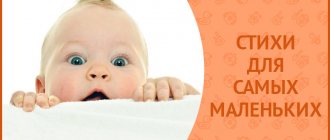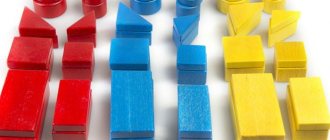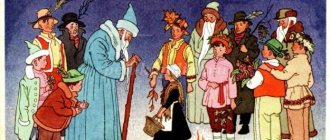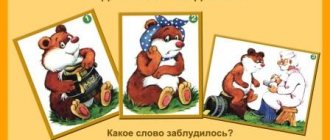What fairy tales does a 2 year old child need?
The age of a child of 2 years is a complex and interesting period in the child’s development, when he begins to realize himself as an individual. A child actively explores the world, absorbing information literally like a sponge. That is why he should be surrounded by good, instructive fairy tales with many positive examples, bright characters, and colorful pictures.
Naturally, at this age the child cannot read, and the perception of fairy tales will depend only on the nature of the mother’s pronunciation of words, her intonation, and the desire to pay attention to a particular accent. Pediatricians recommend selecting literature that strictly corresponds to the baby’s age (manufacturers should indicate this on the covers of publications).
IMPORTANT: Fairy tales and books for a 2-year-old child should have many bright pictures, light syllables, and familiar words to interest the baby.
What books are recommended:
Books: author and title of the tale
Physical development: gross and fine motor skills
From 2 to 3 years old, the child consolidates motor skills, which he became acquainted with gradually from the moment he started. Now he hones his mastery of body and limb control, develops dexterity, and increases the speed and accuracy of movements.
Gross Motor Skills
- The child walks well, runs, jumps on two legs, squats and squats, somersaults, rises and walks on tiptoes, steps over obstacles and crawls under them, confidently jumps from a small height, climbs a wall bars, briefly balances and jumps on one leg, can walk along an inclined board, picks up objects while standing, climbs, without losing balance, up the stairs in alternating steps, at 2 years old independently overcomes the descents and ascents of stairs, by 3 years - without holding onto the railings, dances, repeating movements well and feeling rhythm.
- Catches the ball with both hands, when throwing it hits the target (ring, basket), throws it over obstacles, kicks the ball without losing balance, masters a tricycle, scooter, acquires the first skills of swimming, skating and skiing.
- Performs several actions at the same time: sings, claps his hands, spins, dances.
Fine motor skills
- The child operates well with small and thin objects: he can hold a pencil, pen, felt-tip pen with five or four fingers (by the age of 3 years - with three fingers) and draws simple lines and shapes with them, draws a straight line, copies a circle, sculpts from plasticine, strings beads on lace, flips through a book page by page, controls the index fingers of both hands well, begins to master scissors.
- Assembles a pyramid of eight elements, observing the dimensions, builds a tower of eight cubes, puts together plot structures from cubes (house, bridge, steam locomotive).
- Unfastens and fastens buttons and zippers, Velcro on clothes, tries to tie shoelaces; changes clothes on the doll; masters the buttons on the phone and the computer keyboard; deftly handles a spoon, toothbrush, and comb.
What developmental activities at home does a 2-year-old child need?
Psychologists call the 2-year age of a child (up to 3 years) transitional, this is a milestone in which you can still notice the features of infancy and, nevertheless, see how quickly and rapidly the baby is growing up. The first signs of a baby growing up: his activity, frequent whims, obstinacy, disobedience and disobedience. All this is far from so bad, because the child simply strives to be independent.
IMPORTANT: From the age of 2 years, you need to work with the child, because this is a prerequisite for the development of his personality. In addition, such activities will open up the world to him from a new side, interest him and open his thirst for knowledge.
What classes are needed:
- Games with a constructor. This is not only useful, but also very interesting for the child. Kids love to “tinker” with different shapes and figures of different colors, creating and destroying structures. In modern stores you can find a variety of types of construction sets: wooden, large plastic LEGO, magnetic construction sets.
- Drawing. This is one of the most important activities for kids. You can draw with pencils, brushes, felt-tip pens, regular or finger paints, or draw on sand or a magnetic tablet. Drawing will allow you to explore colors, draw different shapes, and mix paints.
- Modeling from plasticine or salt dough. It perfectly develops the motor skills of the baby’s hands, allows him to learn the structure of materials, create figures and shapes with his own hands. Such activities can only be carried out together and make sure that the child does not put plasticine in his mouth.
- Game with bags. Games for developing motor skills. You need to pour different types of cereals or pasta into several bags (millet, buckwheat, peas, horns. Such bags should be allowed to be felt by the baby or allowed to lower his hand, guessing what exactly is there).
- Game with balls. For such games you will need a large number of large and small balls that need to be rolled, thrown, rotated, tossed, felt (for this it is advisable to choose balls with different surfaces: soft, prickly, pimply, smooth).
- Game with cubes. Very similar to a game with a constructor, the cubes can have pictures or simply be different colors. They can be viewed, folded into structures or lines.
- Educational cartoons. A modern way of developing children, it is only important to choose an age-appropriate cartoon (he will not be interested in a cartoon that is too complex, and a simple one will cause boredom).
- Finger games. Games with attachments for fingers, creating figures using palms, with rhymes and songs (for example, “Magpie Crow”).
- Abacus. In modern toy stores you can buy a variety of mazes in which you can move beads, count them and study their shapes.
- Games in the water. They can be carried out in the summer on reservoirs, in the pool and in the home bathroom at any time of the year. To do this, you should have several bottles, cups or containers that allow you to pour liquid from one to another.
- Active games in the fresh air. Various games with balls, toys, in the sandbox, racing and hide and seek, games with other children.
Developmental activities for a 2 year old child
Activities according to age
Child development is a continuous process. Its success is ensured by the active participation of parents in activities, games and exercises. During impromptu lessons, the child expands his vocabulary, develops perception, logic, memory and attention, develops creativity, and trains strength and endurance. The main conditions for conducting classes are the child’s good mood and a strict time frame (10 minutes).
Any task is performed in a relaxed playful manner. You cannot force a child to study, you can only motivate him with new entertainment.
- To increase your vocabulary, you need to read more to your baby. Reading should be clear and intelligible. Intonation is smooth, but not monotonous. While reading, engage your baby in conversation. For example: “The dog is drawn. The dog is running. Vanechka, where is the dog running?” The same technique is used when watching a cartoon on TV or on a computer.
- To develop speech, articulatory gymnastics are performed. Such gymnastics can be combined with exercises for speech development delay (SDD) prescribed by your doctor. In case of falling behind peers, misunderstanding exercises are used (the parent pretends that he does not understand the baby’s gestures, forcing him to pronounce words) and games to develop fine motor skills.
- The basics of arithmetic and geometry are established at the age of two years. Start by learning shapes from simple to complex. Then master counting up to 10. For example: “Look, here are 2 yellow triangles and 1 red square.” The baby will also get acquainted with the color scheme. Use 3-4 colors. When your child stops getting confused by them, start exploring additional shades. So, when playing with cubes, offer to give you the one that is blue. To consolidate the result, sort the toys with your toddler by color. Don't force them to name them. The main task is to create a correspondence between the visual image and the sound shell of the word. The next step is to study the sizes. The child will learn to determine whether a large, medium or small car has passed.
- To improve memory, games with rearranging and disappearing toys are suitable. Ask your child to put everything back or determine what has changed.
- Creative activities shape the imagination . Do not limit your child's actions. Let him draw or mold from plasticine and dough the figure he came up with. This is how he expresses himself.
- Along with classical activities, you can add a touch of creativity to the aesthetic development of your baby. Try introducing him to blotography - painting with paints using stones. A bizarrely shaped stone is dipped into paint and applied to paper. The kid is trying to use his imagination and determine what this trail looks like. Drawing with paraffin does not arouse interest at first, because there are no traces of children's art left on the picture. But once you cover the paper with watercolors, a full-fledged drawing appears.
- Children's developmental activities should include physical activity. Physical exercises develop dexterity, good coordination, and improve health. Do morning exercises at home, run more and play outdoor games outside.
- To develop a sense of music and rhythm, play themed children's songs and classical compositions to your child. The melodies encourage the baby to dance. Learn some simple and fun moves.
What kind of gymnastics does a 2 year old child need?
The physical development of a child is also not unimportant at the age of 2 years. You should always select activities and exercises for your child, taking into account his characteristics, as well as his mental development. Under no circumstances force your child to do exercises, and if he has a negative attitude towards gymnastics, simply turn the whole process into a game.
What you can do with your child:
- Slow and fast walking teaches the child coordination, proper control of his body and weight management.
- Games with the ball - from passing the ball to each other, to rolling it with your hands and feet. Exercises on a children's fitball with pens are also effective and useful.
- Games with flags are an interesting addition to simple gymnastic exercises that can interest a child.
- Climbing - you can ask your child to climb through a hoop, under a chair, crawl on his hands (like a turtle) or on his knees.
- Overcoming obstacles - it is useful to carry out such games and activities in the fresh air and playgrounds, where there is a choice of obstacles: slides, horizontal bars, swings.
IMPORTANT: Gymnastics should be done every day once or twice a day. Classes should not last more than 15 minutes, as children quickly become overtired. Gymnastics should be performed 40 minutes after eating and 15 minutes after sleep.
How to do gymnastics:
- In comfortable and practical clothes made from natural fabrics
- You need to wear socks on your feet instead of shoes (if classes are held at home).
- The room in which you study needs to be well ventilated.
- Have enough equipment: ball, hoop, mat, toys.
- Below in the picture see a set of exercises with rhymes.
Activities for kids
How to develop speech?
Be sure to tell your child fairy tales and learn simple nursery rhymes and songs together. Children's works, as a rule, have a short, memorable plot, and you can easily perform a mini-play based on them. For example, while reading the same “Teddy Bear,” you can repeat the movements of the furry hero yourself or with the help of your favorite toy.
Be sure to pronounce words clearly, because the child learns to pronounce them based on the sound sample you provide. If he pronounces a word incorrectly, immediately give the correct example.
Communicate with your child. Ask him how he is doing, what interesting things he saw on the street, which paw hurts his favorite bunny, etc. In this regard, role-playing games are very useful, since in them the child learns to correctly use phrases and clichés heard in a similar situation.
What dances are suitable for a 2 year old child?
After 2 years, the child is just beginning to understand his body and walk confidently. Psychologists recommend that a child start dancing from the age of 5, but if the child is active and wants to attend classes, then you should definitely send him to those groups where the children will be of the same age (2-3 years). Dancing at this age is more like active games with movements to music, however, this can become an important part of the child’s physical development.
What movements are suitable for babies:
- Jumping to the music
- Round dances
- Swing your arms up, to the sides, forward and back
- Elevated leg movements
- Jumping from leg to leg
- Head movements left and right
- Pelvic movements
Norm of speech development
Each child is unique and individual, therefore speech development norms are formed according to a certain average indicator. The diagnosis of “speech delay” is not yet made at two years of age. If parents are concerned about the child’s speech development, they can make an appointment with a pediatric neurologist, who will help understand the situation.
The norm is considered to be two years old if the child:
- talks a lot, his vocabulary ranges from 10 to 300 simple words;
- knows how to answer questions with “no” and “yes”;
- says goodbye and hello (or waves);
- understands the requests and speech of an adult;
- points with his hand at different objects and tries to name them.
These standards are established for the age of two to three years, so there is no need to demand the impossible from a child who is barely two years old. Speech therapists recommend that parents carefully monitor the child’s speech development and work with him. You should be wary if within 2-3 months the baby is at the same level of development and does not progress.
What toys do a 2 year old boy and girl need? What educational games does a 2 year old child need?
When buying toys for a child aged 2-3 years, it is important to give preference to those that can develop him, and not just interest him.
What can you buy for your child:
- Constructor. You can choose any type of construction set and each one will be interesting to a child of this age. The main thing is not to choose one that has small details.
- Large puzzles. Made of 4 or more parts so that the child can easily put the drawing together. You can also choose cubes with a pattern.
- Abacus. In the form of real abacus, maze or toys for learning shapes, colors and shapes, as well as basic counting.
- Puzzles. Toys of various shapes (ball, house, square) with cells for figures or labyrinths for a ball.
- Pyramid. Large and small pyramids for learning shapes, shapes and colors.
- Beads. A set for making beads from thick cord and large beads.
- Interactive toys. Talking and singing toys that teach words, animal voices, and numbers.
- Stuffed Toys. Big and small, bright and realistic, the main thing is with kind faces and muzzles (monsters and horror stories will cause aggression in a child).
- Books. With bright pictures, three-dimensional drawings, musical pages.
- Sandbox set. Standard set of bucket, spatula, rakes and set for sand figures.
- Doll. It will be useful for girls to have a favorite doll, preferably large and realistic.
- Machine. A useful and interesting toy not only for boys, but also for girls.
- Ball. Each child should have not one, but several balls of different shapes for playing on the grass, in the water or at home.
- Mosaic. A large mosaic that will teach children to draw pictures, learn shapes and colors.
A very large selection of such toys can be found on the Aliexpress . If you are interested in this topic, follow this link to the catalog of educational toys for kids .
Toys for small children 2 years old
“I myself!”
Allow your child to touch as many objects as possible, study their shape, size, surface quality, color, purpose. It is important for a child to accumulate as much knowledge as possible about the world around him and learn to apply it correctly. Involve your son or daughter in feasible household chores:
- sweep the floor - you can buy a small broom and dustpan;
- wash the dishes after yourself - it’s good if they are made of plastic;
- dress and undress, put clothes and toys in place;
- wash;
- wipe the table with a napkin, etc.
This will make him more independent, help him learn important self-care skills, and give you some free time.
What rhymes does a 2 year old child need?
Games, bathing, eating and dressing the baby can be combined with reading rhymes. This will allow you to turn any process, even the most boring and disliked by the baby, into fun and play.
Our Tanya is crying loudly , she dropped a ball into the river. Hush, Tanya, don't cry! The ball won't drown in the river! A duck swam past and handed Tanya a ball.
Bath rhyme
Rhyme for the game
Educational rhymes for 2 year olds
Poem for games and entertainment
Rhyme for games
What to expect from the three-year crisis
“The three-year crisis” is a rather conventional name: its time period is a year. Some children from 2.5 years old, others later suddenly begin to demonstrate independence, independence, a desire to insist on their own, to prove that they are right. We talk about this in detail here.
Now the baby surprises you: he shows stubbornness, obstinacy and self-will, contradicts you in everything and refuses to do something for the very reason that it was you who demanded it from him. Such negativism is not directed directly at you: now the baby is at war with the whole world, lashing out at everything (and everyone) that gets in his way. This is also a sign of normal development and is an indicator that, psycho-emotionally, the child is more likely to be doing well than vice versa.
What crafts does a 2 year old child need?
Things to do with your child:
- Application made of colored paper. Using dry glue (for neat and quick work). Allows you to get acquainted with colors and odds.
- Modeling from plasticine. You can replace it with plasticine dough or salt dough, learning the structure, shapes, and developing motor skills.
- Application made of cotton wool and cotton sponges. Allows you to create voluminous applications.
- Crafts from cereals. This is not only an active development of hand motor skills, but also an interesting activity for the child.
- In the pictures below, see examples of crafts and applications for 2 year olds.
Crafts from cereals for a 2 year old child
Crafts with cotton wool
Crafts made from colored paper
Crafts from salt dough and plasticine for 2 year olds
Crafts with colored and corrugated paper
Potty training difficulties
When your child turns two years old, potty training should begin actively. Some children start using the potty earlier, others later. There is no specific norm here. If you put in patience and effort, the result will definitely appear.
Tips for potty training parents:
- Accustoming should begin at about a year, maximum at one and a half years. However, results are most often achieved by two to two and a half years. When teaching your child, avoid pressure, be friendly.
- The potty should be placed in a convenient place accessible to the baby.
- At home, take off your baby's diapers. At first he will make puddles all over the house, but soon he will understand where they need to be made.
- Place your child on the potty when his desire to go to the toilet is clearly noticeable. If the child is busy playing, and you tear him off and forcefully put him on the potty, training may be significantly delayed.
- Transformable pots have appeared on sale. The child can first use it like a regular potty, and then sit on a potty attached to the toilet.
Which plasticine modeling is suitable for a 2 year old child?
For sculpting you can use:
- Regular plasticine
- Plasticine dough (Play-Doh)
- Homemade salty dough
What can be molded:
- Tubes
- Balloons
- Flat figures
- Imprinting shapes with molds
- Below in the pictures see figurines for sculpting for 2 year olds.
Flower figurine
Candy made from plasticine tubes
Caterpillar made of plasticine balls
What outdoor games does a 2 year old child need? How to play with a 2 year old child?
How to entertain a child:
- Ball games (football, basketball, water polo, golf, tennis).
- Catch-up (game between children or with parents)
- Hide and seek (game with children and parents)
- Games with juice (catch a ball, butterfly, ball)
- Games with soap bubbles (blow and catch)
- Biking and scootering
- Games in children's labyrinths
- Fishing
- Jumping on a trampoline
IMPORTANT: Parents need to instill a love of active outdoor games in their children, enjoy spending time with their children and actively participate in entertainment.
Why do you need to play in the sandbox?
The sandbox is not only a place where a child makes his first friends. For children, it is a powerful source of tactile sensations and creative opportunities that promote intellectual development.
- The construction of castles, tunnels and other structures awakens imagination.
- Baking Easter cakes and playing with molds help to better distinguish shapes and sizes.
- Interaction with other children develops communication skills and outlook.
- Fine grains of sand provide constant massage to the fingers and palms, which has a beneficial effect on the development of speech and sensory centers.
What cartoons are suitable for children 2 years old and how long can they watch TV?
Pay attention to these cartoons:
- Merry Carousel is an old Soviet serial cartoon with a modern continuation. The cartoon is full of funny music and instructive stories.
- Tiny Love (dubbed) is a cartoon designed for children from 1 year of age, it has a lot of music, educational and developmental moments.
- Malyshariki is a cartoon with funny characters that teach children to behave correctly in different life situations and develop them.
- Masha and the Bear is a cartoon with a good sense of humor that teaches children to behave correctly, learn about the world, make friends and have fun.
IMPORTANT: You can choose a suitable cartoon on any video hosting site, the main thing is to adhere to the search criteria and select cartoons of the appropriate age (2 years). Cartoons should teach colors, shapes, shapes, and new words.
In terms of the duration of TV viewing, focus on episode 1 of the cartoon “Masha and the Bear a Day” plus “Good Night Kids” in the evening, lasting 15 minutes. Total 30 minutes a day. This is the norm.
"Kindergarten" laws
The right of a child to receive preschool education in Russia is guaranteed by the Law “On Education” (Articles 3, 10), and the basic principles of state policy in the field of education are noted:
- the right of everyone to receive education and non-discrimination; education should be free and accessible to all;
- the principle of humanism in education, taking into account the individual characteristics of all children;
- the principle of the value of human life and health, free and comprehensive development of the individual.
In domestic realities, it is advisable for young parents to study this document in detail in order to know their rights. Unfortunately, sometimes you have to defend the rights of the child and your own when communicating with representatives of the educational institution.
Why do we need a kindergarten?
Food for thought. A child spends from 3 to 8 hours in kindergarten. A three-year-old baby is under the supervision of teachers for a third of the day, and sleeps for another third. It turns out that the family and the kindergarten almost equally share responsibility for the development of the child.
The main goal of the preschool education system is the comprehensive development of the child from 0 to six or seven years of age and preparation for the next stage of education - primary school.
To do this, the temporary stay group (formerly the nursery group) and the kindergarten must by law:
- Create a comfortable environment and conditions for the timely neuropsychic and physical development of children.
- Develop speech, perception, attention, memory, thinking, imagination and emotional-volitional sphere.
Does kindergarten teach bad things? A child may “bring” swear words home from classmates, but only mom and dad are responsible for whether the child will use obscene language in the future. The culture of communication is instilled, first of all, through the family. What the child sees at home, he transmits to his peer group. Therefore, blame the kindergarten less and talk to your child more often about “good” behavior.
Depending on the age characteristics of the mental and physical development of children, groups are formed in preschool institutions. Each of them must have a teacher who knows and takes into account these features. Special educational standards and programs have been developed for each age category.
Teachers and educators are called upon not only to supervise children's games, but also to teach students communication and everyday skills. A lot in a little personality depends on the participation, opinion and culture of the teacher. It is the teacher who becomes the most significant adult, besides the mother, who influences:
- Adequacy of self-esteem;
- Social development;
- Moral and ethical ideas;
- Creative skills;
- Self-care skills;
- Study skills (perseverance, attentiveness, interest in learning).
This is not a complete list of the areas of responsibility of preschool teachers, and all this is within the framework of the law. However, you should not shift to the kindergarten those problems that can only be solved within the family.
Who is accepted into kindergartens?
Important document. You will find all the details of the answer to this question in Order of the Ministry of Education and Science of Russia dated 04/08/2014 N 293 “On approval of the Procedure for admission to training in educational programs of preschool education”
Each kindergarten is assigned certain addresses - a territory. If you and your child live with registration in this territory, then you have a priority right to secure a place in the group. If there are free places, admission is open throughout the year.
Groups of healthy children are formed by age. When there are problems, delays, or disharmonies in mental development, individual characteristics are also taken into account. But in any case, no one will assign a three-year-old child to the group of one-and-a-half-year-olds. Children with serious retardation will be offered a specialized kindergarten or group.
What documents are needed
To ensure that your child’s preparation for kindergarten is not delayed due to the legal side of the issue, study in advance the list of documents for admission to kindergarten:
- medical report (medical record);
- personal statement of one of the parents.
The medical record must contain mandatory studies and notes from medical examinations by specialists, a list of which is always available from the local doctor. Typically these include a dentist, neurologist, urologist-andrologist or gynecologist, surgeon, orthopedist, ophthalmologist and cardiologist, but individual kindergartens may have other requirements for medical examination.
If you have to change kindergarten, be sure to check with the administration of the institution. In any case, the kindergarten doctor must check the availability of vaccinations according to age. It is also necessary to present originals and provide copies of:
- mom's or dad's passport;
- child's birth certificate;
- information about the official registration of the child at the place of residence or place of stay.
Based on these documents, the preschool educational institution enters into an agreement with the parents, and within 3 working days the child must be enrolled in a group according to age. A two-year-old child will be assigned to a temporary stay group, and at three years old - to a full-time kindergarten.
Charitable contributions. Contributions for “roof repair”, “purchase of curtains and cabinets” are not mandatory, they are voluntary. Kindergartens are provided with everything they need from the budget. You are not obliged to make urgent payments, other than payment for services under the contract. You also should not buy something for the group if such a decision was not made at the parent meeting.
Where can you go with a 2 year old child?
In modern big and small cities there are always entertaining and educational rooms for children:
- Indoor playgrounds
- Trampolines and mazes
- Montessori school for little ones
- Drawing lessons (any creativity)
- Dance and gymnastics club
Where else can you go with a 2-year-old child:
- To the dolphinarium
- In the pool
- To the park (lunar park, amusement park)
- To the zoo
- To the puppet theater
Upcoming purchases
Do not try to provide your child with a separate wardrobe for visiting the group. Ordinary household items are quite suitable. Moreover, when the number of children in a group is more than 12, even the most experienced nanny will miss the moment when borscht is turned over onto a new shirt, and felt-tip pens are tested on white tights.
The most necessary clothes
- light trousers for walking outside in summer (knees are protected);
- summer headdress;
- light socks (several pairs);
- comfortable sandals or sports shoes;
- warm overalls for winter walks;
- turtlenecks, sweaters, pullovers - depending on the climate;
- warm hat;
- warm socks;
- warm boots or boots according to the climate;
- shorts for the group (choose cotton products with soft elastic and without pockets);
- tights (several pairs);
- pajamas for quiet time (two per shift);
- long sleeve shirts;
- short sleeve shirts;
- T-shirt and trousers for sports activities, dancing and choreography;
- Czech shoes or dancing slippers (according to garden requirements);
It is better to avoid jeans and go to the garden every morning, depending on the season - in trousers or shorts with a soft belt and a cotton shirt.
The child should be comfortable dressing and undressing independently. An individual locker should contain a change of linen, a small towel, and in winter - spare mittens. Replaceable shoes - reliable, breathable, comfortable (not slippers or flip-flops!).
Dress uniform: usually it is enough to comply with the requirement “dark bottom, light top.” Shoes for events – closed leather. This attire will be needed 3-4 times a year on official occasions: September 1, Teacher's Day, Russian Flag Day, Constitution Day. Students of junior groups rarely participate in such events. Carnival costumes for matinees and additional accessories are at the discretion of the parents.
Advice. You should not prepare clothes long before the start of the school year. First, check the requirements for casual and dress uniforms directly with the institution. In addition, children from 2 to 6 years old grow very quickly and it is better to make purchases in size throughout the year.







